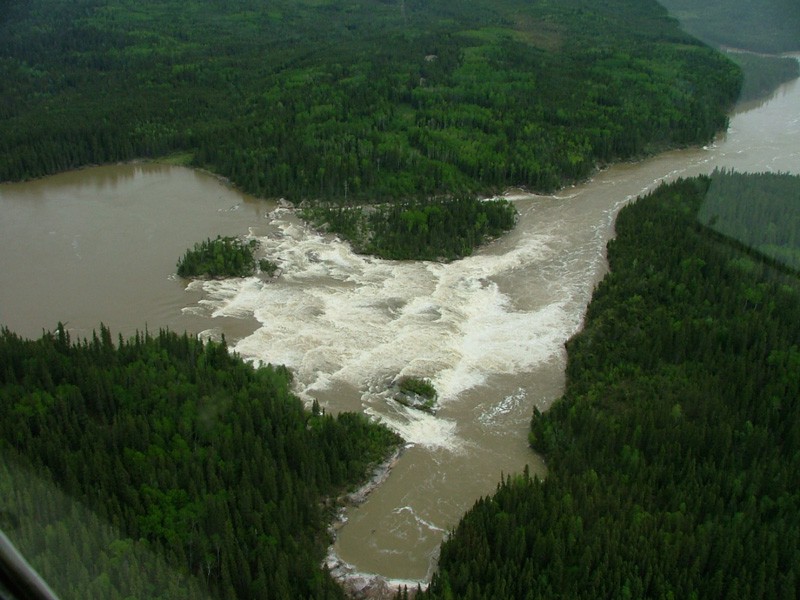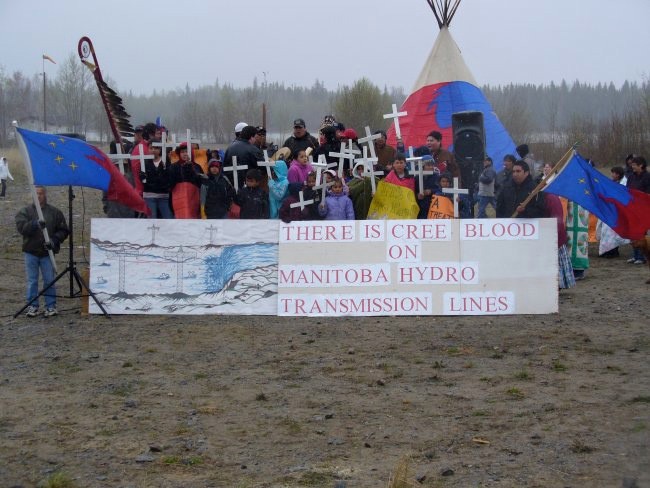
As public hearings around Enbridge’s Northern Gateway pipeline begin, national attention is focused more than ever on the major debates related to tarsands development in Alberta and, increasingly, Saskatchewan. Quietly slipping under the public radar, it appears, is another significant set of energy projects that are not likely to gain major media time or space: the continued development of hydroelectric energy in northern Manitoba.
Travelling up the Nelson River, it’s easy to see the impacts of hydro development. The once-pristine water is now silty and not to be trusted for drinking. Trees fall into the river everywhere along the shore, thanks to erosion caused by constantly fluctuating water levels. Ancient graves are being exposed, and sacred sites are now under water. What was once a highway for hunters is now dangerous to travel in winter, as the location of ice pockets created by flooding and retreating water cannot be predicted. A river that was once the basis for life has become deadly.
When the Churchill River Diversion and Lake Winnipeg Regulation projects were undertaken in the 1970s, national attention was riveted by the Mackenzie pipeline project of that era and the struggle against hydro development megaprojects in northern Quebec. Although the communities affected by the Churchill River and Lake Winnipeg projects were sufficiently united and gained enough public support within the province to force a modern treaty on Manitoba Hydro, known as the Northern Flood Agreement, the terms of that agreement and the systematic violation of it that ensued over the next decade were no doubt influenced by the low national profile of these projects.
History is about to repeat itself as a new wave of dams is currently under development with equally little media attention. Have you heard of the Wuskwatim project? Or Keeyask?
Around much of northern Manitoba, “hydro” is a dirty word, and for good reason. These projects have reconfigured the landscape of the entire region, drying whole rivers and engorging lakes. Mercury has likely been released into the groundwater, and wildlife habitat has been destroyed.
Manitoba Hydro has a racially stratified work force: the highly paid technical and administrative work is done by non-Native southerners, and the few jobs that northern Cree workers can get are low-paid and menial.
In the Grand Rapids hydro facility, as in most others, Aboriginal employees push brooms and fill plates for more highly paid engineers from the south. The community is divided between a nearly impoverished First Nation and municipality, and a prosperous suburban community built by Manitoba Hydro for its employees. Hydro employees’ houses have two electricity meters as their bills are subsidized by the utility, while nearby Aboriginal residents are not given any reprieve when their power is cut off due to unpaid bills.
Among the Cree of northern Manitoba, it is clear that the end result of the Churchill River Diversion and Lake Winnipeg Regulation projects, and the inexpensive hydro rates they have made available to southern Manitobans, is ecological and social devastation.
The Great Falls Dam, built in 1923, was the first of four on the Winnipeg River. It was constructed without any consultation with the First Nation most affected by the project (Sagkeeng, at that time known as Fort Alexander), as were the 1960 Kelsey Generating Station on the Nelson River and the 1965 Grand Rapids dam on the Saskatchewan River.
The latter project involved the wholesale relocation of the community of Chemawawin to Easterville. It also completely disrupted the Grand Rapids First Nation (now Misipawistik), located at the site of construction, by drying up the site of the once-sacred rapids, flooding land, and every year sending more debris into the river and lake, making fishing much more difficult.
By the early 1970s, plans for further major hydro developments were under way, which eventually led to the Churchill River Diversion and Lake Winnipeg Regulation projects. These projects reshaped the whole hydrology of northern Manitoba, to the detriment of six Cree communities.
When construction for these projects first began, the five First Nations affected came together to form the Northern Flood Committee. While they were entirely opposed to the proposed projects, they eventually conceded to a negotiated settlement, the Northern Flood Agreement (NFA), which allowed development to proceed. Like Chemawawin, the community of South
Indian Lake was entirely relocated and effectively destroyed as a fishing community due to project-related flooding.
The NFA made many promises. A much-quoted schedule attached to the agreement detailed the promotion of studies for the purpose of the “alleviation of mass poverty and unemployment,” which many read as a substantive commitment. However, within a few years it became clear that Manitoba Hydro and the provincial government were not interested in implementing the agreement in good faith.
Rather than creating prosperity for nearby communities, hydro-related flooding has immiserated them. Eventually, Manitoba Hydro planners began to pursue even more dams, but since Aboriginal rights were now constitutionally recognized, they needed the co-operation of communities where their actions had created a legacy of hatred. Thus, Manitoba Hydro offered each community, separately, a financial settlement for what were called “implementation agreements.” They succeeded in getting four of the five First Nations to sign on, which was sufficient to proceed with a new wave of projects.
The first dam, Wuskwatim, on the Burntwood River, is expected to be finished this year. This project is to be followed by a much larger one, the Keeyask, on the lower Nelson River, and then another, Conawapa, also on the Nelson River. Two other dams, Notigi and Gillam Island, are on Manitoba Hydro’s wish list. The power generated by these dams is not needed in Manitoba, but will instead be exported to the United States.
After the NFA was signed in the 1970s, the Northern Flood Committee linking communities opposed to hydro development ceased to exist.
Among the reasons for Hydro’s continued colonial success is that it now deals with communities one at a time, so opposition is fragmented. However, one of the five NFA signatories, Pimicikamak (formerly Cross Lake), has still not signed an implementation agreement and stands outside Hydro’s current paradigm, fighting for actual implementation of the NFA. They have been enormously creative in their political resistance, developing their own governance system and generally making life difficult by trying to force the utility to live up to its promises. Whether they, and the opposition groups in Tataskweyak, Nisichawayasihk, and elsewhere, manage to make any gains will depend in part on their story getting a wider hearing in Canada and internationally than it has so far.






